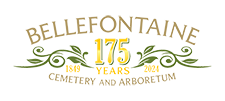As we approach the middle of winter here at Bellefontaine Cemetery, we are imagining the lush green landscape and blooms of spring. With this eagerness for all things green to return, Vice President of Customer Relations, Gracie Griffin, held two Green Burial presentations for the public during the last week of January.
Green burial is the oldest and most traditional form of burial, having been utilized for thousands of years. In fact, other burial practices such as embalming and cremation did not become common in the United States until the 19th century.
Here is a look back at the changes in burial practices in the United States*:
1500s-1600s: Spanish Colonial Burial Practices
- Spanish settlers on the east coast of Florida frequently buried their dead in Roman Catholic churchyards. These graves were unmarked with the dead wrapped in shrouds. Archaeologists have found no trace of coffins or hardware.[1]
1600s: Practices of Puritan New England
- While Spanish colonialists chose to bury their dead in churchyards and consecrated grounds near their churches, puritans rejected burial in religious grounds.[2] Instead, they opted for a common area outside their villages on land with no religious affiliation.[3] Some of these community burial grounds have headstones that favor secular imagery.
1600-1700s: Mid Atlantic Practices
-

Stephen Hempstead head stone in the original Hempstead family cemetery now part of Bellefontaine Cemetery Early settlement towns such as Jamestown were comprised of large family plantations and farms which gave rise to family cemeteries.[4] Burial practices on family farms differed from family to family. Bodies would be washed, dressed and groomed and placed into plain wooden coffins. According to Karol Weaver, historian and author, states that in some cases in the latter half of the 18th century “layers removed internal organs, applied alcohol, and filled body cavities with charcoal to retard putrefaction.”[5] Some may view this practice as a precursor to embalming.
1800s: Rural Cemetery Movement/Civil War
- The rural cemetery movement grew popular in the early 1800s, favoring thenatural landscapes on the outskirts of cities. Bellefontaine Cemetery, founded in 1849, was a product of this movement along with many other famous cemeteries including Mount Auburn, Laurel Hill and Green-Wood Cemetery to name a few. Burial practices in this time were largely changed by the advent of civil war, with a focus on preserving and returning the bodies of soldiers who lost their lives.[6] It was in this period that embalming became a widespread practice utilized by the majority of those who could afford it.
1900s: Turn of the Century
- While there are various reasons cremation became popular in the United States, one reason was the idea that it was the modern and hygienic approach.[7] Following the civil war, several epidemics plagued the United States. Cholera took the lives of over 4,000 people in St. Louis in 1849. With these widespread diseases came panic that dead bodies could transfer illness to the living. Cremation gained popularity in the 1980s and remains popular today.
2000s: Green Burial
- With a rise in environmental consciousness in the 21st century, a revival of natural burial practices has gained notoriety. The practice of green burial, simple enshrouding or casketing in a biodegradable container, leaves the most minimal carbon footprint in terms of burial options. This practice is known as an affordable alternative to conventional burial that honors both the deceased and the environment.

Evergreen Meadow – Dedicated Green Burial Section Bellefontaine Cemetery
Learn more about green burial options by contacting Gracie Griffin (314) 381-0750 or via email at GGriffin@bellefontainecemetery.org.
To findout when Gracie’s next Green Burial talk will be, sign up for our quarterly Bellefontaine emails. SIGN UP
Written by Madeline Scott
* This is NOT a comprehensive overview of all burial practices, but rather an overview of general practices leading up to today.
[1] https://www.nps.gov/nr/publications/bulletins/nrb41/nrb41_5.htm [2] Davies, Horton. The Worship of American Puritans, 1629-1730. 195. [3] http://teachersinstitute.yale.edu/curriculum/units/2003/2/03.02.01.x.html [4] https://www.nps.gov/nr/publications/bulletins/nrb41/nrb41_5.htm [5] http://philadelphiaencyclopedia.org/archive/funerals-and-burial-practices/ [6] https://worldhistory.us/american-history/early-american-embalming-methods.php [7] https://decorative-urns.com/cremation-blog/about-cremation/the-history-of-cremation-in-north-america/


Post a comment